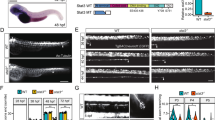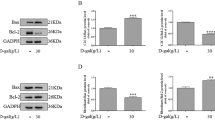Abstract
β-Catenin is essential for muscle development because it regulates both cadherin-mediated cell-cell adhesion and canonical Wingless and Int1 (Wnt) signaling. The phosphorylation of β-catenin by glycogen synthase kinase-3β (GSK-3β) at serine31/37/threonine41 regulates its stability and its role in canonical Wnt signaling. In this study, we have investigated whether the N-terminal phosphorylation of β-catenin is regulated by M-cadherin, and whether this regulation mediates the role of M-cadherin in myogenic differentiation. Our data show that the knockdown of M-cadherin expression by RNA interference (RNAi) in C2C12 myoblasts significantly increases the phosphorylation of β-catenin at Ser33/37/Thr41 and decreases the protein abundance of ser37/thr41-unphosphorylated active β-catenin. Furthermore, M-cadherin RNAi promotes TCF/LEF transcription activity but also blunts the initiation of the myogenic progress by Wnt pathway activator lithium chloride or Wnt-3a treatment. Knockdown of β-catenin expression by RNAi decreases myogenic induction in myoblasts. Forced expression of a phosphorylation-resistant β-catenin plasmid (S33Y-β-catenin) fails to enhance myogenic differentiation, but it partially rescues C2C12 cells from M-cadherin RNAi-induced apoptosis. These data show, for the first time, that M-cadherin-mediated signaling attenuates β-catenin phosphorylation at Ser31/37/Thr41 by GSK-3β, and that this regulation has a positive effect on myogenic differentiation induced by canonical Wnt signaling.












Similar content being viewed by others
References
Almeida M, Han L, Bellido T, Manolagas SC, Kousteni S (2005) Wnt proteins prevent apoptosis of both uncommitted osteoblast progenitors and differentiated osteoblasts by beta-catenin-dependent and -independent signaling cascades involving Src/ERK and phosphatidylinositol 3-kinase/AKT. J Biol Chem 280:41342–41351
Armstrong DD, Esser KA (2005) Wnt/beta-catenin signaling activates growth-control genes during overload-induced skeletal muscle hypertrophy. Am J Physiol Cell Physiol 289:C853–C859
Armstrong DD, Wong VL, Esser KA (2006) Expression of beta-catenin is necessary for physiological growth of adult skeletal muscle. Am J Physiol Cell Physiol 291:C185–C188
Bernardi H, Gay S, Fedon Y, Vernus B, Bonnieu A, Bacou F (2011) Wnt4 activates the canonical beta-catenin pathway and regulates negatively myostatin: functional implication in myogenesis. Am J Physiol Cell Physiol 300:C1122–C1138
Borello U, Coletta M, Tajbakhsh S, Leyns L, De Robertis EM, Buckingham M, Cossu G (1999) Transplacental delivery of the Wnt antagonist Frzb1 inhibits development of caudal paraxial mesoderm and skeletal myogenesis in mouse embryos. Development 126:4247–4255
Brack AS, Conboy MJ, Roy S, Lee M, Kuo CJ, Keller C, Rando TA (2007) Increased Wnt signaling during aging alters muscle stem cell fate and increases fibrosis. Science 317:807–810
Brack AS, Conboy IM, Conboy MJ, Shen J, Rando TA (2008) A temporal switch from notch to Wnt signaling in muscle stem cells is necessary for normal adult myogenesis. Cell Stem Cell 2:50–59
Breitbart RE, Nadal-Ginard B (1987) Developmentally induced, muscle-specific trans factors control the differential splicing of alternative and constitutive troponin T exons. Cell 49:793–803
Charrasse S, Meriane M, Comunale F, Blangy A, Gauthier-Rouviere C (2002) N-cadherin-dependent cell-cell contact regulates Rho GTPases and beta-catenin localization in mouse C2C12 myoblasts. J Cell Biol 158:953–965
Charrasse S, Comunale F, Grumbach Y, Poulat F, Blangy A, Gauthier-Rouviere C (2006) RhoA GTPase regulates M-cadherin activity and myoblast fusion. Mol Biol Cell 17:749–759
Charrasse S, Comunale F, Fortier M, Portales-Casamar E, Debant A, Gauthier-Rouviere C (2007) M-cadherin activates Rac1 GTPase through the Rho-GEF trio during myoblast fusion. Mol Biol Cell 18:1734–1743
Cossu G, Kelly R, Tajbakhsh S, Di DS, Vivarelli E, Buckingham M (1996) Activation of different myogenic pathways: myf-5 is induced by the neural tube and MyoD by the dorsal ectoderm in mouse paraxial mesoderm. Development 122:429–437
Du WJ, Li JK, Wang QY, Hou JB, Yu B (2009) Lithium chloride preconditioning optimizes skeletal myoblast functions for cellular cardiomyoplasty in vitro via glycogen synthase kinase-3beta/beta-catenin signaling. Cells Tissues Organs 190:11–19
Goichberg P, Shtutman M, Ben Ze’ev A, Geiger B (2001) Recruitment of beta-catenin to cadherin-mediated intercellular adhesions is involved in myogenic induction. J Cell Sci 114:1309–1319
Gottardi CJ, Gumbiner BM (2001) Adhesion signaling: how beta-catenin interacts with its partners. Curr Biol 11:R792–R794
Gottardi CJ, Wong E, Gumbiner BM (2001) E-cadherin suppresses cellular transformation by inhibiting beta-catenin signaling in an adhesion-independent manner. J Cell Biol 153:1049–1060
Hahn JY, Cho HJ, Bae JW, Yuk HS, Kim KI, Park KW, Koo BK, Chae IH, Shin CS, Oh BH, Choi YS, Park YB, Kim HS (2006) Beta-catenin overexpression reduces myocardial infarct size through differential effects on cardiomyocytes and cardiac fibroblasts. J Biol Chem 281:30979–30989
Hall MN, Griffin CA, Simionescu A, Corbett AH, Pavlath GK (2011) Distinct roles for classical nuclear import receptors in the growth of multinucleated muscle cells. Dev Biol 357:248–258
Hao Y, Jackson JR, Wang Y, Edens N, Pereira SL, Alway SE (2011) Beta-hydroxy-beta-methylbutyrate reduces myonuclear apoptosis during recovery from hind limb suspension-induced muscle fiber atrophy in aged rats. Am J Physiol Regul Integr Comp Physiol 301:R701–R715
Hart M, Concordet JP, Lassot I, Albert I, del los Santos R, Durand H, Perret C, Rubinfeld B, Margottin F, Benarous R, Polakis P (1999) The F-box protein beta-TrCP associates with phosphorylated beta-catenin and regulates its activity in the cell. Curr Biol 9:207–210
Hendriksen J, Fagotto F, van der Velde H, van Schie M, Noordermeer J, Fornerod M (2005) RanBP3 enhances nuclear export of active (beta)-catenin independently of CRM1. J Cell Biol 171:785–797
Ikeda S, Kishida S, Yamamoto H, Murai H, Koyama S, Kikuchi A (1998) Axin, a negative regulator of the Wnt signaling pathway, forms a complex with GSK-3beta and beta-catenin and promotes GSK-3beta-dependent phosphorylation of beta-catenin. EMBO J 17:1371–1384
Ishibe S, Haydu JE, Togawa A, Marlier A, Cantley LG (2006) Cell confluence regulates hepatocyte growth factor-stimulated cell morphogenesis in a beta-catenin-dependent manner. Mol Cell Biol 26:9232–9243
Ishitani T, Ninomiya-Tsuji J, Matsumoto K (2003) Regulation of lymphoid enhancer factor 1/T-cell factor by mitogen-activated protein kinase-related Nemo-like kinase-dependent phosphorylation in Wnt/beta-catenin signaling. Mol Cell Biol 23:1379–1389
Kim CH, Neiswender H, Baik EJ, Xiong WC, Mei L (2008) Beta-catenin interacts with MyoD and regulates its transcription activity. Mol Cell Biol 28:2941–2951
Klein PS, Melton DA (1996) A molecular mechanism for the effect of lithium on development. Proc Natl Acad Sci USA 93:8455–8459
Kuphal F, Behrens J (2006) E-cadherin modulates Wnt-dependent transcription in colorectal cancer cells but does not alter Wnt-independent gene expression in fibroblasts. Exp Cell Res 312:457–467
Lavulo LT, Uaesoontrachoon K, Mirams M, White JD, Cockett NE, Mackie EJ, Pagel CN (2008) Myoblasts isolated from hypertrophy-responsive callipyge muscles show altered growth rates and increased resistance to serum deprivation-induced apoptosis. Cells Tissues Organs 187:141–151
Le TL, Yap AS, Stow JL (1999) Recycling of E-cadherin: a potential mechanism for regulating cadherin dynamics. J Cell Biol 146:219–232
Li J, Xuan W, Yan R, Tropak MB, Jean-St-Michel E, Liang W, Gladstone R, Backx PH, Kharbanda RK, Redington AN (2011) Remote preconditioning provides potent cardioprotection via PI3K/Akt activation and is associated with nuclear accumulation of beta-catenin. Clin Sci (Lond) 120:451–462
Liu C, Li Y, Semenov M, Han C, Baeg GH, Tan Y, Zhang Z, Lin X, He X (2002) Control of beta-catenin phosphorylation/degradation by a dual-kinase mechanism. Cell 108:837–847
Liu C, Gersch RP, Hawke TJ, Hadjiargyrou M (2010) Silencing of Mustn1 inhibits myogenic fusion and differentiation. Am J Physiol Cell Physiol 298:C1100–C1108
Maher MT, Flozak AS, Stocker AM, Chenn A, Gottardi CJ (2009) Activity of the beta-catenin phosphodestruction complex at cell-cell contacts is enhanced by cadherin-based adhesion. J Cell Biol 186:219–228
Nelson WJ, Nusse R (2004) Convergence of Wnt, beta-catenin, and cadherin pathways. Science 303:1483–1487
Pan W, Jia Y, Wang J, Tao D, Gan X, Tsiokas L, Jing N, Wu D, Li L (2005) Beta-catenin regulates myogenesis by relieving I-mfa-mediated suppression of myogenic regulatory factors in P19 cells. Proc Natl Acad Sci USA 102:17378–17383
Polesskaya A, Seale P, Rudnicki MA (2003) Wnt signaling induces the myogenic specification of resident CD45+ adult stem cells during muscle regeneration. Cell 113:841–852
Rochat A, Fernandez A, Vandromme M, Moles JP, Bouschet T, Carnac G, Lamb NJ (2004) Insulin and wnt1 pathways cooperate to induce reserve cell activation in differentiation and myotube hypertrophy. Mol Biol Cell 15:4544–4555
Sadot E, Simcha I, Shtutman M, Ben-Ze’ev A, Geiger B (1998) Inhibition of beta-catenin-mediated transactivation by cadherin derivatives. Proc Natl Acad Sci USA 95:15339–15344
Silberstein L, Webster SG, Travis M, Blau HM (1986) Developmental progression of myosin gene expression in cultured muscle cells. Cell 46:1075–1081
Simcha I, Kirkpatrick C, Sadot E, Shtutman M, Polevoy G, Geiger B, Peifer M, Ben-Ze’ev A (2001) Cadherin sequences that inhibit beta-catenin signaling: a study in yeast and mammalian cells. Mol Biol Cell 12:1177–1188
Siu PM, Pistilli EE, Butler DC, Alway SE (2005) Aging influences cellular and molecular responses of apoptosis to skeletal muscle unloading. Am J Physiol Cell Physiol 288:C338–C349
Staal FJ, Noort MM, Strous GJ, Clevers HC (2002) Wnt signals are transmitted through N-terminally dephosphorylated beta-catenin. EMBO Rep 3:63–68
Starkey JD, Yamamoto M, Yamamoto S, Goldhamer DJ (2011) Skeletal muscle satellite cells are committed to myogenesis and do not spontaneously adopt nonmyogenic fates. J Histochem Cytochem 59:33–46
Steel MD, Puddicombe SM, Hamilton LM, Powell RM, Holloway JW, Holgate ST, Davies DE, Collins JE (2005) Beta-catenin/T-cell factor-mediated transcription is modulated by cell density in human bronchial epithelial cells. Int J Biochem Cell Biol 37:1281–1295
Stockinger A, Eger A, Wolf J, Beug H, Foisner R (2001) E-cadherin regulates cell growth by modulating proliferation-dependent beta-catenin transcriptional activity. J Cell Biol 154:1185–1196
Tajbakhsh S, Borello U, Vivarelli E, Kelly R, Papkoff J, Duprez D, Buckingham M, Cossu G (1998) Differential activation of Myf5 and MyoD by different Wnts in explants of mouse paraxial mesoderm and the later activation of myogenesis in the absence of Myf5. Development 125:4155–4162
Tanaka S, Terada K, Nohno T (2011) Canonical Wnt signaling is involved in switching from cell proliferation to myogenic differentiation of mouse myoblast cells. J Mol Signal 6:12
van Noort M, Meeldijk J, van der Zee R, Destree O, Clevers H (2002) Wnt signaling controls the phosphorylation status of beta-catenin. J Biol Chem 277:17901–17905
Van Vliet E, Melis M, Foidart JM, Van Ewijk W (1986) Reticular fibroblasts in peripheral lymphoid organs identified by a monoclonal antibody. J Histochem Cytochem 34:883–890
Vincan E, Leet CS, Reyes NI, Dilley RJ, Thomas RJ, Phillips WA (2000) Sodium butyrate-induced differentiation of human LIM2537 colon cancer cells decreases GSK-3beta activity and increases levels of both membrane-bound and Apc/axin/GSK-3beta complex-associated pools of beta-catenin. Oncol Res 12:193–201
Wang Y, Hao Y, Alway SE (2011) Suppression of GSK-3β activation by M-cadherin protects myoblasts against mitochondrial-associated apoptosis during myogenic differentiation. J Cell Sci 124:3835–3847
Wrobel E, Brzoska E, Moraczewski J (2007) M-cadherin and beta-catenin participate in differentiation of rat satellite cells. Eur J Cell Biol 86:99–109
Yao Y, Nakamura M, Miyazaki JI, Kirinoki M, Hirabayashi T (1992) Expression pattern of skeletal muscle troponin T isoforms is fixed in cell lineage. Dev Biol 151:531–540
Zammit PS, Partridge TA, Yablonka-Reuveni Z (2006) The skeletal muscle satellite cell: the stem cell that came in from the cold. J Histochem Cytochem 54:1177–1191
Zhang L, Zhou F, van Laar T, Zhang J, van Dam H, ten Dijke DP (2011) Fas-associated factor 1 antagonizes Wnt signaling by promoting beta-catenin degradation. Mol Biol Cell 22:1617–1624
Zhang L, Shi S, Zhang J, Zhou F, ten Dijke P (2012) Wnt/beta-catenin signaling changes C2C12 myoblast proliferation and differentiation by inducing Id3 expression. Biochem Biophys Res Commun 419:83–88
Acknowledgements
We acknowledge assistance from Karen H. Martin, Ph.D. and the West Virginia University Microscope Imaging Facility (supported by the Mary Babb Randolph Cancer Center and NIH grant 5P20RR016440-09). We are also grateful to Pinnian He, Ph.D. and her laboratory personnel for help with luciferase activity measurements and to Yanlei Hao, Ph.D. for additional technical assistance.
Author information
Authors and Affiliations
Corresponding author
Additional information
This work was supported by NIH R01AG021530.
Rights and permissions
About this article
Cite this article
Wang, Y., Mohamed, J.S. & Alway, S.E. M-cadherin-inhibited phosphorylation of ß-catenin augments differentiation of mouse myoblasts. Cell Tissue Res 351, 183–200 (2013). https://doi.org/10.1007/s00441-012-1515-4
Received:
Accepted:
Published:
Issue Date:
DOI: https://doi.org/10.1007/s00441-012-1515-4




